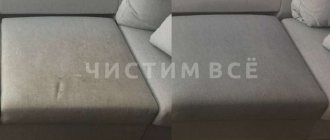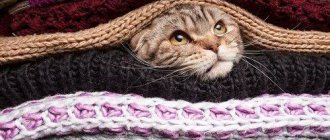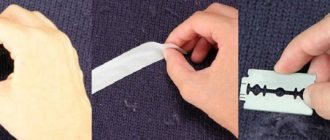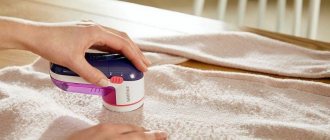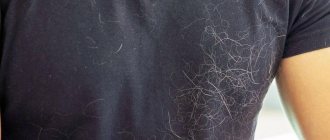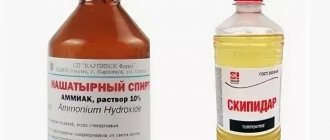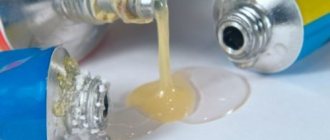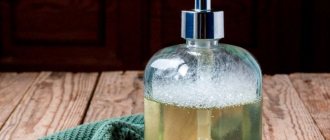How to remove pills from socks?
The pellets can be carefully cut off with a razor or a machine with a small grid diameter. If the socks are made of thick yarn, they must be combed out with a comb or removed with nail scissors.
Interesting materials:
Who plays Dota? Who plays lol? Which animal searches for truffles? Who studied the territory of Central Asia? Who has studied Central Asia? Who controls the SBU? Who controls the labor inspectorate? Who is the Queen of New Zealand? Who dyes carrots underground answer? Who loves black?
How to easily get rid of pilling on clothes: 6 ways
Where do the pellets come from?
Photo: malbaskhan.com The “mechanism” for the appearance of pills on different types of fabric is the same: the fibers of the threads that make up the material become tangled due to regular friction, forming small balls that spoil the appearance of things. Pills are more likely to appear if: - the fabric contains synthetics + natural fibers; — the thread from which the knitwear is knitted is made of acrylic; - fabric or knitwear is made of loose thread with long fibers; — the fabric was not properly cared for (for example, washed with inappropriate products); - fabric or knitwear has been subjected to regular friction (for example, a sweater or T-shirt can constantly rub against a belt or bag).
How to properly care for outerwear
6 ways to get rid of pellets
Special machine
Photo: haushalts-helfer.net The small machine is equipped with something like a razor that cuts off the pellets. Suitable for: smooth knitwear (cotton, acrylic, acrylic+wool, wool), smooth fabrics. Pros: quickly removes pellets from large surfaces. Cons: not suitable for mohair, angora, can ruin textured fabric or knitwear.
Detergents
Photo: avespendsplurge.com It is stated that special products remove pilling from clothes in a certain chemical way, softening the fibers of the threads. Suitable for: knitted, mainly woolen items. Pros: gently untangles thread fibers, eliminating pellets and preventing new ones from forming. Cons: may not work if the threads are very tangled, not suitable for some types of fabrics (see product instructions).
Razor
Photo: napadynavody. sk Fabric or knitwear should be stretched on the surface and carefully shaved with a safety razor. Suitable for: cotton knitwear, smooth knitted items made of acrylic or acrylic with wool, smooth fabrics. Pros: quickly removes even small pellets from large surfaces. Cons: due to inexperience, it is easy to cut fabric with a razor; the method is not suitable for textured knitwear and fabrics; After several treatments, the fabric may become thinner and lose its appearance.
Scissors
Photo: favecrafts.com It is better to use small scissors with thin sharp tips: carefully cut off each pellet with them. Suitable for: knitwear and fabrics made from fluffy, fleecy threads (including mohair and angora). Pros: getting rid of large pellets. Cons: long processing time, there is a possibility of damaging the fabric with scissors.
Scotch tape roller
Photo: childinjurylawyerblog.com Just stick the tape to the places that need to be rid of pellets and tear it off. Use the roller in the same way as when removing animal hair and lint from clothing. Suitable for: knitwear and fabrics made from fluffy, fleecy threads (including mohair and angora). Pros: the most gentle effect on the fabric. Cons: not the most effective and fastest method.
Toothbrush, comb
Photo: lookarabia.com Using a brush or comb with fine teeth, comb the fabric or knitwear, straightening/removing the pellets. Suitable for: knitwear and fabrics made of fluffy, fluffy threads (including mohair and angora), brush - for textured fabrics and knitwear. Pros: gentle on fabric. Cons: low efficiency (brush), it is possible to make puffs on knitwear (comb).
Knitwear: fashion, sewing, care
How to prevent the formation of pellets?
Photo: partymilk. club - Wash your clothes by first turning them inside out. — Follow the instructions on the label of the item, select detergents and washing modes that are suitable for the type of fabric, and do not forget about conditioner. — Do not wash coats, jackets, furniture covers, large woolen scarves and shawls and similar items, but take them to the dry cleaner. — Wash knitwear made from “capricious” materials (alpaca, fine mohair, angora, etc.) by hand. — Do not machine dry items that are prone to pilling.
Features of getting rid of pills from clothes
The type of clothing also influences the choice of method and technology of work. Below are some tips.
Wool coat
A coat is an expensive item that, if properly cared for, will last for many years. It is better to take such clothes to the dry cleaner. It is enough to do this once a year.
If it is not possible to turn to professionals, then clothes are washed with liquid products using a softening agent. Dry only on hangers. Store separately from other clothing.
To remove pills from the coat, it is put on a mannequin or a person. Use a sticky roller, a special trimmer, a razor or the hard side of a sponge.
Sweater
Sweaters, T-shirts, sweatshirts, cardigans can be easily processed on an ironing board. The fastened item is placed on the protruding part of the board, turning it over as necessary. The cleaning method depends on the type of fabric.
Hats
It is convenient to clean the hat by putting it on your hand. Typically, such products have an uneven surface, so it is not recommended to use a razor, as it can cut the material. A small area can be easily treated with a comb and scissors.
To watch the video:
Removal from pants
Jeans are rarely covered with pilling due to the tight twisting of the fibers when weaving the fabric. This problem occurs on low-quality material or fabrics with stretch. Wool pants are more likely to suffer from this problem.
It is most convenient to work with an assistant. One person puts on pants, and the other removes the pellets with a washcloth, razor or trimmer.
Tights and socks
You can remove pellets from tights using a special machine or razor. To do this, the item is pulled over the hand. Do the same with socks as with tights.
Bed sheets
The bed linen has a large area. It is spread directly on the bed, and pillowcases are put on the pillows. Use any method depending on the fabric.
Life hack 1 - tape or adhesive tape
Regular stationery tape will help you remove hated hairballs from your favorite clothes. This is done very simply. Cut a small piece of adhesive tape, press it firmly against the problem area on the clothing and tear it off with a sharp movement. Repeat this movement several times, since you most likely will not be able to remove all the pellets in one go. This is such a useful use of an ordinary thing.
Important:
This method of removing pellets is suitable for things where pellets have just begun to form. If you want to get rid of pellets that have formed a long time ago, you need to use other methods.
Where do the pellets come from?
thespruce.com
They appear on fabric when groups of short or damaged fibers intertwine into a tiny ball. This usually occurs as a result of friction or abrasion from the fabric during normal wear.
As a rule, the most pilling appears on those areas of clothing or bedding that are exposed to the greatest impact from everyday use. For example, in the center of the sheet, under the arms, around the collar and cuff of a shirt, and between the thighs and on the back of pants. But it also happens that pellets appear where you don’t expect them at all.
It is difficult to say whether pills form on a particular fabric. However, there are still some types of fabrics and fibers that are more susceptible to pilling. The most striking example is knitwear, because the threads of such fabric are looser. But fabrics made from long fibers - for example, silk and linen - pill less than wool, cotton, polyester and other synthetics. When a fabric is made from different fibers, such as a cotton/polyester blend, one fiber is usually stronger than the other. As a result, the weaker one will tear, tie itself around the stronger one and form a hated tangle.
During washing, such a ball will become a kind of magnet for other loose threads, which will eventually get tangled. This is why white pellets appear on black fabric: they simply consist of other, weaker fibers.
Lifehack 4 - old men's razor
This method is ancient, almost everyone knows about it. Suitable for caring for smooth items, especially socks, knitted tights, hats. Where the knitted fabric is smooth, without patterns. In this case, it is best to use an old razor that is already slightly dull. A new one can easily cut the product.
How to remove pills from clothes at home using a razor:
- Stretch and secure the wool fabric so that you can handle it comfortably. Moreover, you should not stretch it too much - this can cause the clothes to stretch and lose their shape.
- Lean the razor against the surface of the fabric, without pressing it, but as if from above, cut off the pellets from the clothing. Run the razor from bottom to top across the clothing to catch as many pellets as possible.
- In this way, clean all the places on the sweater where pills have formed.
How to remove pills from clothes with a razor
Important:
This is a rather aggressive way to remove pellets from clothes; there is a high probability of cutting the fabric. Not suitable for caring for angora, cashmere, and mohair.
What to do to prevent pellets from forming
After you have found a suitable way to deal with pellets, it’s time to think about how to prevent them from appearing again.
Use these tips:
- Do not neglect and follow the instructions;
- Do not soak the item or wash it with rough fabrics;
- Use conditioner;
- Buy quality powders, conditioners and rinses. They will not harm things;
- Do not wring or rub delicate fabrics.
By following these tips, you will no longer think about how to get rid of such an unpleasant problem as pellets.
As soon as you notice the first pellets, try to remove them immediately. Don't wait for a huge number of them to appear. When there are few of them, it is much easier to cope. Clothes with pilling look worn and not beautiful.
This is another reason why it is necessary to get rid of them in a timely manner. Take care of your things and look well-groomed, as well as feel much more comfortable and confident.
Lifehack 10 - dry cleaning
Pills on clothes on expensive delicate fabrics are best removed by dry cleaning. This method is quite expensive, but it will allow you to save your favorite thing and not spoil it. In addition, you will have a guarantee that you will receive it back in perfect condition and without stains.
Advice:
This method of removing pills from clothes is suitable when you have already tried all the home methods and nothing has worked for you. The dry cleaner will clean your favorite wool pants quickly and easily.
Characteristics of fabrics and their properties
Natural fabrics
The group of natural fabrics are those made from animal or plant materials. These include: cotton, linen, wool, silk. Natural fabrics have low pilling properties. Natural cotton, linen, and silk do not form pills.
Artificial fabrics
They have low pillability. Disadvantages include severe creasing. Synthetic fabrics (synthetics) are made entirely from polymers.
These include:
- Polyester
- Elastane (also known under the names: spandex, lycra, elastane (trademark of the Invista company), dorslastan (trademark of Asahi kasei), lynel (from the company Fillattice)
- Acrylic (artificial wool)
- Polyamide, also known as nylon
Synthetic fabrics that have not undergone special treatment are prone to periodic persistent formation (pellets), which worsens the appearance of the products. Products made of polyamide (nylon, kodur), nylon, lavsan (polyester and polyamide fibers) are especially susceptible to pilling. Of the synthetic fabrics, acrylic fibers are least prone to pilling.
Mixed fabrics
These are natural fabrics with the addition of synthetic fibers. For example, polycotton (cotton-based fabric) may contain 60% cotton, 40% polyester. Blended fabrics are very common. By adding synthetic fibers to natural ones, manufacturers achieve improved basic properties. Such fabrics are more wear-resistant, wrinkle-resistant, and elastic. But they have a drawback - with a large percentage of synthetics in the composition, the formation of pellets is inevitable!
Knitted fabrics
Knitwear – from the French tricotage “knit” – fabrics that differ from fabrics in the method of production. Its structure is interconnected loops. In the production of knitwear, various fibers are used - cotton, wool, synthetic, mixed. Whether or not pilling occurs on a knitted product depends on the fibers used and the processing.
Lifehack 6 - haircut
If large pills form on clothing, you can simply cut them off with sharp scissors. This is a rather long and labor-intensive process, how to remove pills from a sweater? since you will need to cut off the lumps one by one, one by one. There is also a possibility of damaging wool trousers, a dress or a jacket.
Advice:
To make it easier for you to remove pellets, comb your sweater first with a fine-toothed comb. The comb will remove the smallest lumps and it will be easier for you to remove all the remaining pellets.
Prevention measures
What to do to prevent the problem from occurring:
- You need to wash your favorite items according to the label that is attached to the clothes. Do not exceed the temperature range or use automatic spinning if this is contraindicated.
- Fabrics that require careful handling should only be washed by hand using special products for this type of material.
- Use conditioner designed for rinsing.
- Do not use bleaches on synthetic fabrics.
To prevent pilling, it is recommended to avoid excessive rubbing of clothing against the bag.
Carrying a bag always on one shoulder can cause pilling
Lifehack 5 - sandpaper
Fine-grit sandpaper is a great alternative for removing pellets if you don't have a razor or machine at hand. They work with sandpaper just like with an old razor. Stretch and fix the woolen fabric, using sandpaper to remove lumps of wool from the pile of the sweater, working from bottom to top.
Advice:
If your favorite sweater pills heavily and quickly, you can use the sandpaper method every week. This will not ruin your clothes.
How to prevent
- If you suspect pilling may appear on certain items of clothing, wash only on a gentle cycle. Lower spin speeds and shorter wash cycles will protect your clothes. If you don't want to take risks, wash by hand.
- However, no matter whether you choose to hand wash or machine wash, turn your clothes inside out first. This will prevent additional abrasion of the fabric surface from other clothing, zippers and buttons.
- Also remember to carefully sort your laundry before loading it into the machine. For example, washing delicate items together with jeans will cause more damage to the surface of the fabric. Also try not to wash terry cloth (or any other fabric with long pile) together with other types of clothing. Because if the polyester already has damaged fibers - and you are unlikely to know it - then in the drum the terry cloth pile will stick to the polyester surface.
- Do not overload the washing machine tank. If you overload it, there will be no room for your clothes to move freely, causing them to become damaged.
- Avoid harsh cleaners and harmful bleach, which can weaken the fibers, causing them to break and pill.
- Choose a laundry detergent that contains cellulose. This enzyme helps break down the pellets and removes them.
- For the rinse cycle, add any fabric softener. The fabric softener ingredients it contains will coat the fabric fibers with an extra layer, reducing abrasion.
- Try to dry clothes naturally - that is, by hanging them - and store them on a flat surface. If you do use a dryer, remove delicate items from the dryer as soon as possible to reduce abrasion from other fabrics.
Lifehack 9 - bread crumbs
A very unusual thing can help you in removing pellets from woolen items - bread crumbs. You can use this method to remove pills from clothes if you have nothing else at hand. You will need a thick piece of cracker; thin pieces will crumble quickly. The easiest way is to dry it yourself in the oven or naturally. Moreover, you need to dry the cleaning rusk on a non-greasy surface, otherwise your clothes will acquire a greasy sheen. And choose loose bread for drying so that it removes unnecessary lint from the fabric.
After drying the bread, simply use it to clean the pellets from your clothes. They will cling to it and be removed from the clothes.
Features of removing pellets from different materials
When choosing a method for removing pellets, it is worth considering the type of material. Then the cleaning will be most effective.
Woolen
Wool is a fleecy fabric whose fibers mat even with proper care. To put the material in order without spoiling it, use the following means:
- Combination of comb and scissors. Small pellets are combed out with a comb, and the remains are cut off with scissors.
- Hair products. The rolled material is first washed in hair shampoo. Then the fabric is soaked in balm or conditioner and left for an hour. Clothes are rinsed thoroughly.
- Toothbrush. It is used like a comb.
Complement the topic of the video:
Cashmere
Cashmere is another type of fleecy fabric. To clean it, the same methods are used as for wool. When using an electric trimmer, use the attachment for delicate fabrics.
Knitwear
Knitwear is not a fleecy material. To clean it, it is recommended to use:
- tape and sticky roller;
- sponge;
- razor;
- standard electric trimmer attachment.
Drape
Drape is a rough coat fabric. To remove pellets from such textiles use:
- razor;
- standard trimmer attachment;
- tape and adhesive tape;
- scissors (without comb);
- sandpaper;
- sponge;
- crackers.
